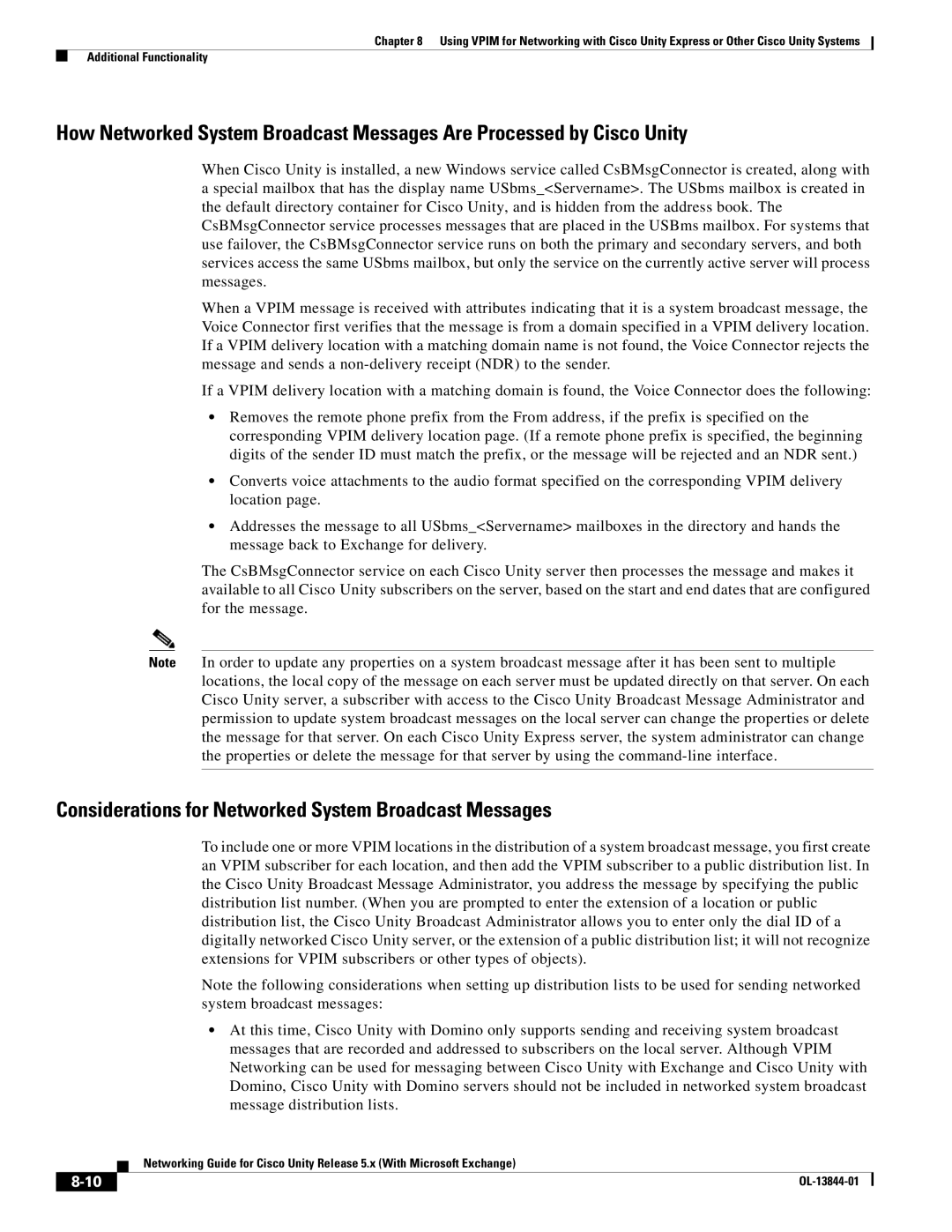
Chapter 8 Using VPIM for Networking with Cisco Unity Express or Other Cisco Unity Systems
Additional Functionality
How Networked System Broadcast Messages Are Processed by Cisco Unity
When Cisco Unity is installed, a new Windows service called CsBMsgConnector is created, along with a special mailbox that has the display name USbms_<Servername>. The USbms mailbox is created in the default directory container for Cisco Unity, and is hidden from the address book. The CsBMsgConnector service processes messages that are placed in the USBms mailbox. For systems that use failover, the CsBMsgConnector service runs on both the primary and secondary servers, and both services access the same USbms mailbox, but only the service on the currently active server will process messages.
When a VPIM message is received with attributes indicating that it is a system broadcast message, the Voice Connector first verifies that the message is from a domain specified in a VPIM delivery location. If a VPIM delivery location with a matching domain name is not found, the Voice Connector rejects the message and sends a
If a VPIM delivery location with a matching domain is found, the Voice Connector does the following:
•Removes the remote phone prefix from the From address, if the prefix is specified on the corresponding VPIM delivery location page. (If a remote phone prefix is specified, the beginning digits of the sender ID must match the prefix, or the message will be rejected and an NDR sent.)
•Converts voice attachments to the audio format specified on the corresponding VPIM delivery location page.
•Addresses the message to all USbms_<Servername> mailboxes in the directory and hands the message back to Exchange for delivery.
The CsBMsgConnector service on each Cisco Unity server then processes the message and makes it available to all Cisco Unity subscribers on the server, based on the start and end dates that are configured for the message.
Note In order to update any properties on a system broadcast message after it has been sent to multiple locations, the local copy of the message on each server must be updated directly on that server. On each Cisco Unity server, a subscriber with access to the Cisco Unity Broadcast Message Administrator and permission to update system broadcast messages on the local server can change the properties or delete the message for that server. On each Cisco Unity Express server, the system administrator can change the properties or delete the message for that server by using the
Considerations for Networked System Broadcast Messages
To include one or more VPIM locations in the distribution of a system broadcast message, you first create an VPIM subscriber for each location, and then add the VPIM subscriber to a public distribution list. In the Cisco Unity Broadcast Message Administrator, you address the message by specifying the public distribution list number. (When you are prompted to enter the extension of a location or public distribution list, the Cisco Unity Broadcast Administrator allows you to enter only the dial ID of a digitally networked Cisco Unity server, or the extension of a public distribution list; it will not recognize extensions for VPIM subscribers or other types of objects).
Note the following considerations when setting up distribution lists to be used for sending networked system broadcast messages:
•At this time, Cisco Unity with Domino only supports sending and receiving system broadcast messages that are recorded and addressed to subscribers on the local server. Although VPIM Networking can be used for messaging between Cisco Unity with Exchange and Cisco Unity with Domino, Cisco Unity with Domino servers should not be included in networked system broadcast message distribution lists.
| Networking Guide for Cisco Unity Release 5.x (With Microsoft Exchange) |
|
